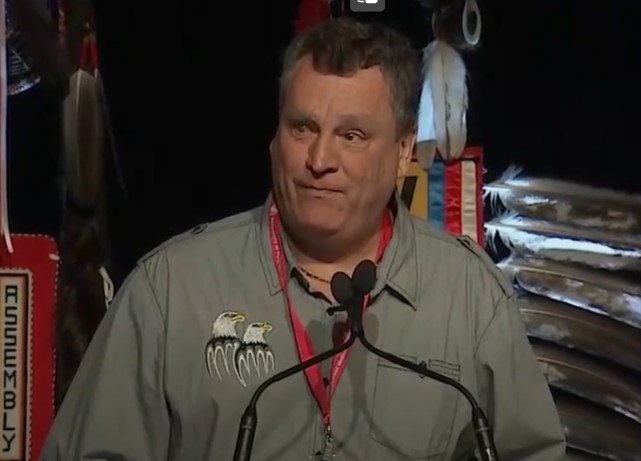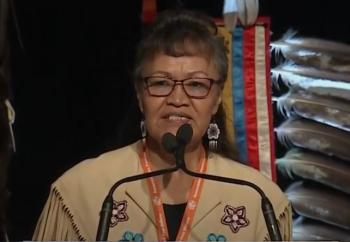Image Caption
Summary
Local Journalism Initiative Reporter
Windspeaker.com
In 2019, Vuntut Gwitchin First Nation in North Yukon inside the Arctic Circle became the first community in Canada to declare a climate emergency.
The declaration stated that First Nations’ voices were not being heard and that governments “around the world are not sufficiently responsive to the dire circumstances already being directly experienced and the implications for the health of animal populations, food security, as well as our communities’ emotional, cultural, and physical well-being.”
Vuntut Gwitchin Elder and knowledge keeper Lorraine Netro told chiefs last week that “in the last five years or more, the landscape in each of our regions has been changing before our very eyes.”
Chiefs gathered at the Assembly of First Nations annual general assembly in Halifax July 10 to July 13 and passed the resolution Urgent and Transformative Climate Action through the AFN National Climate Strategy.
The resolution was moved by proxy Judy Wilson for the Osoyoos Indian Band in British Columbia and seconded by Chief Terry Richardson of Papineau First Nation in New Brunswick.
The resolution reaffirms that “climate crisis constitutes a state of emergency for our lands, waters, animals and people.”

“Climate change is real. We’re in a climate crisis. And it’s changing our way of being on this Mother Earth,” said Netro.
It’s real and being felt across the country. Richardson listed the impact climate change is having on the east coast, with rising water causing communities to flood; great white sharks off the coast where they have never been before; salmon dying because the water is too warm; animals mating off season.
And with two months still left in the fire season, a record 10 million hectares of land has already burned this year in Canada.
“It’s a state of emergency. It is. Against our lands, our people, the animals,” said Richardson.
In 2019, chiefs-in-assembly passed the motion submitted by the Vuntut Gwitchin First Nation Declaring a First Nations Climate Emergency, which provided direction to develop a First Nations-led climate strategy, which was delivered to the chiefs July 12. National-Climate-Strategy-Discussion-Paper.pdf (bynder.com)
That strategy, said Wilson, came as a result of two national gatherings and input from 1,000 First Nation experts, leaders, youth, knowledge keepers, professionals, allies and others.
“All of our water and all of our land are impacted by the climate crisis. And it is manmade. So we have to come up with these solutions and it has to be Indigenous led,” said Wilson.
It’s a new direction and different from the past when First Nations participated in government-led processes.
Central to the work of the AFN National Climate Strategy, says the resolution, is a First Nations climate lens. That lens includes natural law, context, impacts and action. When combined, that lens “(brings) into focus how First Nations solutions can re-frame the climate conversation towards transformative and systemic change.”
Through the First Nations climate lens, says the AFN National Climate Strategy, there is a “fundamental reframing of the climate discourse.”
There is a transition away from technological solutions towards “a framing that emphasizes the centrality of First Nations’ rights, self-determination and knowledge systems.”
This emphasis underscores that First Nations are “inseparable from the lands, waters and air.”
The climate strategy sets out seven key priority areas, including addressing capacity needs to support First Nations governance and their role as climate leaders; ensuring First Nations self-sufficiency in food, water, and energy; equipping First Nations with the ability to mitigate, prevent, respond to and recover from all emergencies; and closing infrastructure gaps.
The resolution stresses the importance of federal, provincial and territorial governments to work with First Nations rights and title holders to implement their own strategies to address climate priorities.
The resolution directs the AFN to work with First Nations to obtain sustainable funding from all levels of government to implement climate strategies.
The resolution also calls on the AFN to use the national climate strategy as an advocacy tool in national and international contexts.
“Everything that we do today. All the decisions that our leaders are making today is not about us. It’s for our future generations. Seven generations from now. For all those of our babies that are not yet born. And so the work that we do to try to be part of the solution is so very, very critical. And very critical for us to be part of that solution,” said Netro.
Local Journalism Initiative Reporters are supported by a financial contribution made by the Government of Canada.

